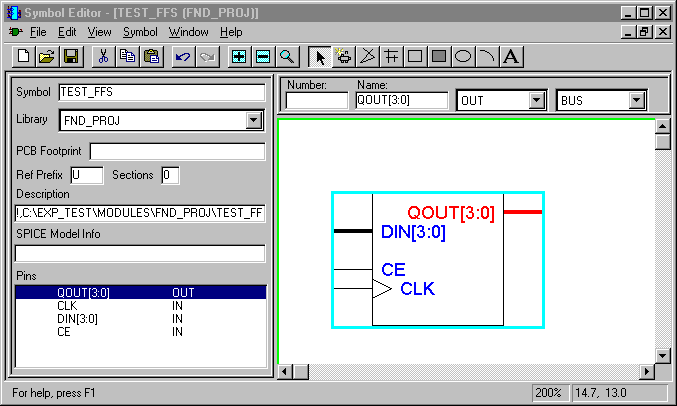Answers Database
FPGA Express 1.2/Foundation 1.3: Creating HDL Macros with FPGA Express 1.2 for Placement on a Foundation 1.3 Top-Level Schematic

Record #3013
Product Family: Software
Product Line: Synopsys
Problem Title:
FPGA Express 1.2/Foundation 1.3: Creating HDL Macros with FPGA Express
1.2 for Placement on a Foundation 1.3 Top-Level Schematic
Problem Description:
Keywords: macro, HDL, Verilog, VHDL, FPGA Express, Foundation, 1.2, 1.3
Urgency: Standard
General Description:
FPGA Express v1.2 can be used as a module generator. An HDL design can be
synthesized with FPGA Express and the Express XNF can be placed in a
Foundation 1.3 schematic.
For this solution using Foundation 1.4 and FPGA Express 2.0,
see (Xilinx Solution 3301).
Solution 1:
(1) Create the Foundation Project
The Foundation project should be created first. If the porject has not yet
been created, select File->New Project (in the Foundation Project Manager) and
choose the appropriate device family and specify a project name. For more
information on creating and working with Foundation projects, refer to the the
Foundation F1.3 Quickstart Guide and Online Help.
(2) Compile the HDL Code in FPGA Express
Create a project in FPGA Express, if the project does not already exist, and
synthesize the HDL design as described in the FPGA Express documentation.
When performing the 'Create Implementation' step, be sure that the 'Do not
insert I/O pads' box is checked:

Figure 1- Do not insert I/O pads
When performing the 'Export Netlist' step in FPGA Express, browse to the
Foundation project directory created above, and save the netlist into this
directory.
(3) Modify the Netlinst
The XNF file created by FPGA Express must be modified to replace all of the
'EXT' records with 'SIG' records. This can be done manually with any text
editor. Alternatively, the ext2sig.pl Perl script can perform this function.
Please refer to (Xilinx Solution 2843) in the Xilinx Answers Database for more
information on this script.
(4) Importing the Netlist into a Foundation Schematic
IMPORTANT: With Foundation F1.3, there is a bug with the XNF to EDIF
translation flow, described in (Xilinx Solution 3330). We recommend following
the steps in that solution rather than continuing with this solution for steps
4 through 6. If you are instantiating XNF files without INV properties,
continue here.
Open the Foundation project created in Step 1. To import the XNF from FPGA
Express into the Foundation schematic, select Hierarchy->Import Netlist from
the Schematic Editor. This will import the netlist into the Foundation
project, and create an associated symbol for placement on the schematic.
Connectivity between this symbol and the XNF file is done by name, so do not
change the name of one without changing the name of the other.
The symbol will be automatically be added to the Foundadtion project library.
To place the symbol on the schematic, brows the the 'SC Symbols' list of
library components to find the module. The name of the module will be the
same as the name of the imported XNF netlist. To bring up the 'SC Symbols'
list, click the SC Symbols icon on the vertical toolbar:

Figure 2- SC Symbol Icon
(5) Modify the Symbol
The symbol for the imported netlist will not have bus pins. If you wish to
create bus pins, double-click on the symbol, and then click the 'Symbol Editor'
button to invoke the Symbol Editor. Once in the Symbol Editor, bus pins can
be created, and the corresponding individual pins may be delted. When naming
a bus pin, use the notation BUS_NAME[3:0], where BUS_NAME is the name of the
bus, and [3:0] is an example of the bounds of the bus.

Figure 3- Symbol Editor
(6) Simulate the Design
To functionally simulate the design, enter the Logic Simulator by clicking
the 'SIM Funct' button in the Foundation Project Manager. The design,
including the FPGA Express generated XNF netlist, will be loaded into the
simulator. To perform timing simulation, follow the Foundation procedures
for timing simulation as if the design were a pure schematic.
Note: The M1.3 core technology software, like Verilog, is case-sensitive with
respect to names. VHDL is not case-sensitive, but the XNF written out by FPGA
Express will follow the case-sensitivity used in the Verilog or VHDL code.
If case-sensitivity is not followed consitently when making constraints, the
M1.3 software may not be able to properly merge FPGA Express v1.2 XNF with
EDN files from Foundation 1.3.
End of Record #3013

| For the latest news, design tips, and patch information on the Xilinx design environment, check out the Xilinx Expert Journals! |



